1998 PONTIAC GRAND PRIX service indicator
[x] Cancel search: service indicatorPage 92 of 402

LOCK (B): Before you put the key into the ignition
switch, the switch is in LOCK. It’s
also the only position
from which you can remove your key.
This position
locks your ignition, steering wheel and transaxle. It’s a
theft-deterrent feature.
OFF (C): This position lets you turn off the engine but
still turn the steering wheel. It doesn’t lock the steering
wheel like
LOCK. Use OFF if you must have your
vehicle pushed or towed.
RUN (D): This position is where the key returns
after you start your vehicle. With the engine
off, you
can use RUN to display some of your warning and
indicator lights.
START (E): This position starts your engine.
A warning chime will sound if you open the driver’s
door when the ignition is in
OFF, LOCK or
ACCESSORY and the key is in the ignition.
NOTICE:
If your key seem stuck in LOCK and you can’t
turn it, be sure you are using the correct key;
if
so, is it all the way in? If it is, then turn the
steering wheel left and right while
you turn the
key hard. But turn the key only with your hand.
Using a tool to force it could break the key
or the
ignition switch.
If none of this works, then your
vehicle needs service.
Retained Accessory Power
With retained accessory power, your power windows, audio system and sunroof will continue to work up to
10 minutes after the ignition key is turned to OFF and
none of the doors are opened.
Starting Your Engine
Move your shift lever to PARK (P) or NEUTRAL (N).
Your engine won’t start in any other position -- that’s a
safety feature.
To restart when you’re already moving,
use
NEUTRAL (N) only.
2-17
~~
Page 144 of 402
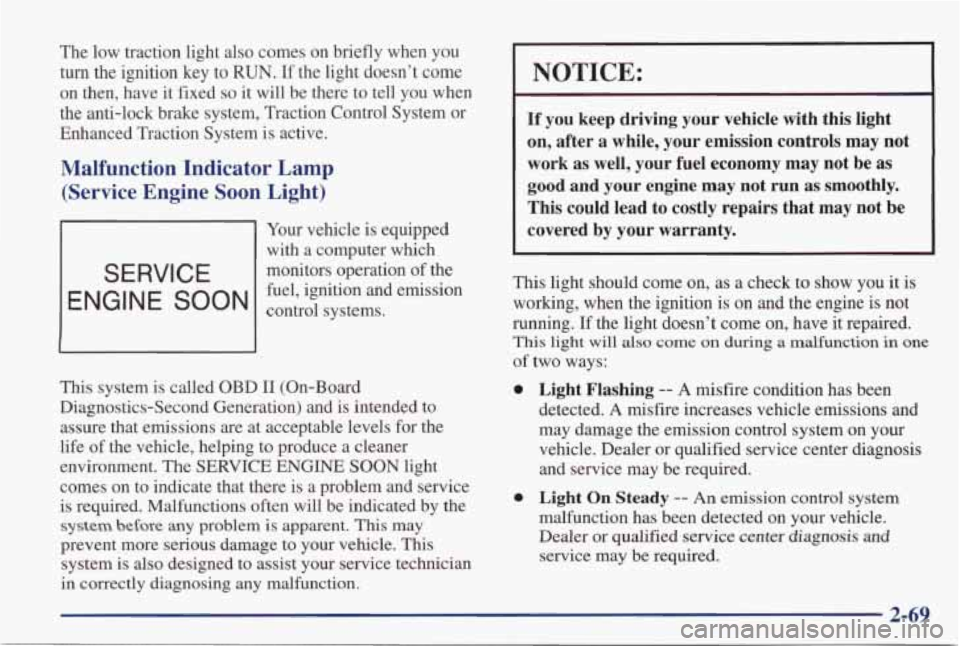
The low traction light also comes on briefly when you
turn the ignition key to RUN. If the light doesn’t come
on then, have
it fixed so it will be there to tell you when
the anti-lock brake system, Traction Control System or Enhanced Traction System is active.
Malfunction Indicator Lamp
(Service Engine Soon Light)
SERVICE
ENGINE SOON
Your vehicle is equipped
with a computer which
monitors operation of the
fuel, ignition and emission
control systems.
This system is called OBD
I1 (On-Board
Diagnostics-Second Generation) and is intended to assure that emissions are at acceptable levels for the
life of the vehicle, helping to produce a cleaner
environment. The
SERVICE ENGINE SOON light
comes on to indicate that there is a problem and service is required. Malfunctions often will be indicated by the
system before any problem is apparent. This may
prevent more serious damage to your vehicle. This system is also designed to assist your service technician
in correctly diagnosing
any malfunction.
NOTICE:
If you keep driving your vehicle with this light
on, after a while, your emission controls may not
work as well, your fuel economy may not be
as
good and your engine may not run as smoothly.
This could lead to costly repairs that may not
be
covered by your warranty.
This light should come on, as a check to show you it is
working, when the ignition is on and the engine is not
running. If the light doesn’t come on, have it repaired.
This light will also come on during a malfunction in one
of two ways:
0
a
Light Flashing -- A misfire condition has been
detected.
A misfire increases vehicle emissions and
may damage the emission control system on your
vehicle. Dealer or qualified service center diagnosis
and service may be required.
Light On Steady -- An emission control system
malfunction has been detected on your vehicle.
Dealer or qualified service center
diagnosis and
service may be required.
2-69
Page 150 of 402
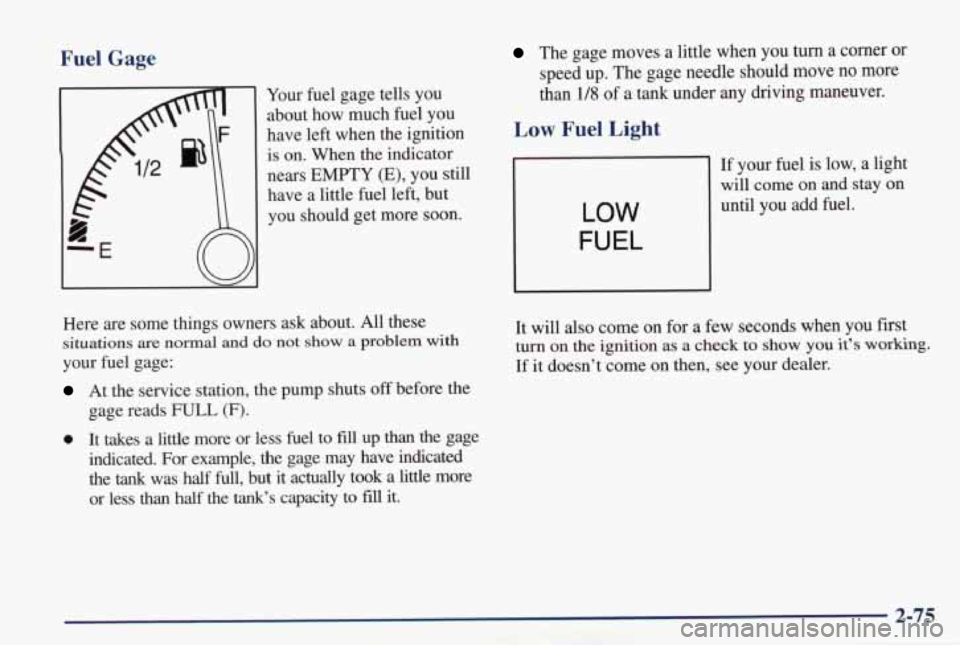
Fuel Gage
Your fuel gage tells you
about how much fuel you
have left when the ignition
is on. When the indicator
nears
EMPTY (E), you still
have a little fuel left, but
you should get more soon.
Here are some things owners ask about. All these
situations are normal and do not show a problem with
your fuel gage:
At the service station, the pump shuts off before the
gage reads
FULL (F).
0 It takes a little more or less fuel to fill up than the gage
indicated. For example, the gage may have indicated
the
tank was half full, but it actually took a little more
or less than
half the tank‘s capacity to fill it.
The gage moves a little when you turn a comer or
speed up. The gage needle should move no more
than 1/8 of a tank under any driving maneuver.
Low Fuel Light
If your fuel is low, a light
will come on and
stay on
until you add fuel.
LOW
FUEL
It will also come on for a few seconds when you first
turn on the ignition as a check to show you it’s working.
If it doesn’t come on then, see your dealer.
2-75
Page 279 of 402
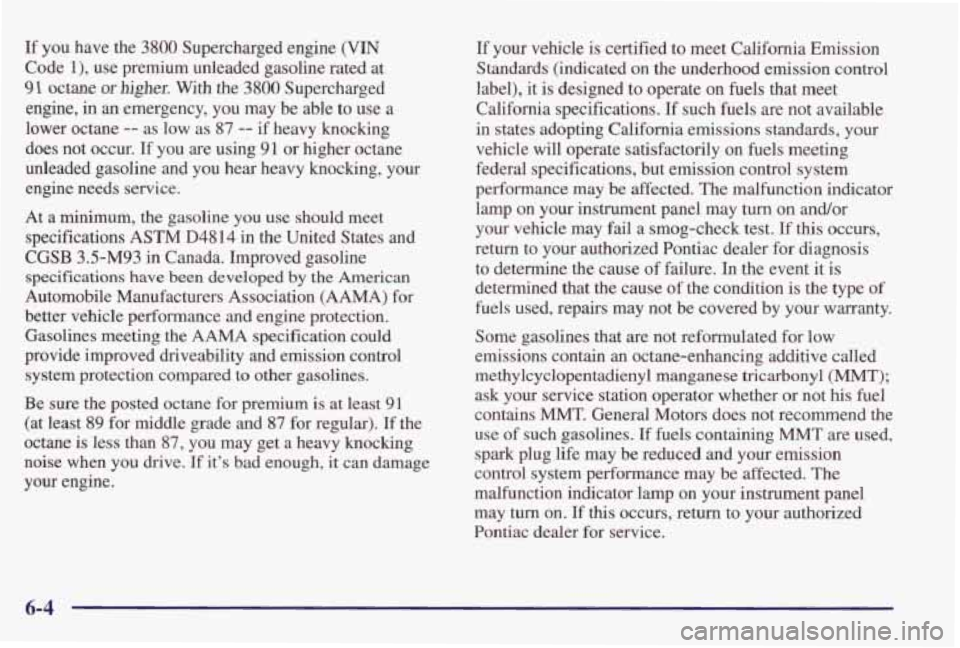
If you have the 3800 Supercharged engine (VIN
Code l), use premium unleaded gasoline rated at
91 octane or higher. With the 3800 Supercharged
engine, in
an emergency, you may be able to use a
lower octane
-- as low as 87 -- if heavy knocking
does not occur. If you are using 91 or higher octane
unleaded gasoline and you hear heavy knocking, your engine needs service.
At a minimum, the gasoline you
use should meet
specifications
ASTM D4814 in the United States and
CGSB 3.5-M93 in Canada. Improved gasoline
specifications have been developed by the American
Automobile Manufacturers Association
(AAMA) for
better vehicle performance and engine protection. Gasolines meeting
the AAMA specification could
provide improved driveability and emission control system protection compared to other gasolines.
Be sure the posted octane for premium
is at least 91
(at least 89 for middle grade and 87 for regular). If the
octane is less than
87, you may get a heavy knocking
noise
when you drive. If it’s bad enough, it can damage
your engine.
If your vehicle is certified to meet California Emission
Standards (indicated on the underhood emission control
label), it is designed to operate on fuels that meet
California specifications. If such fuels are not available
in states adopting California emissions standards, your
vehicle will operate satisfactorily on fuels meeting
federal specifications, but emission control system
performance may be
affected. The malfunction indicator
lamp on your instrument panel may turn on andor
your vehicle may fail a smog-check test.
If this occurs,
return to your authorized Pontiac dealer for diagnosis
to determine the cause of failure.
In the event it is
determined that the cause
of the condition is the type of
fuels used, repairs may not be covered by your warranty.
Some gasolines that are not reformulated for low
emissions contain
an octane-enhancing additive called
methylcyclopentadienyl manganese tricarbonyl
(MMT);
ask your service station operator whether or not his fuel
contains
MMT. General Motors does not recommend the
use
of such gasolines. If fuels containing MMT are used,
spark plug life may be reduced and your emission
control system performance may be affected. The
malfunction indicator lamp on your instrument panel
may turn on. If
this occurs, return to your authorized
Pontiac dealer for service.
6-4
Page 294 of 402
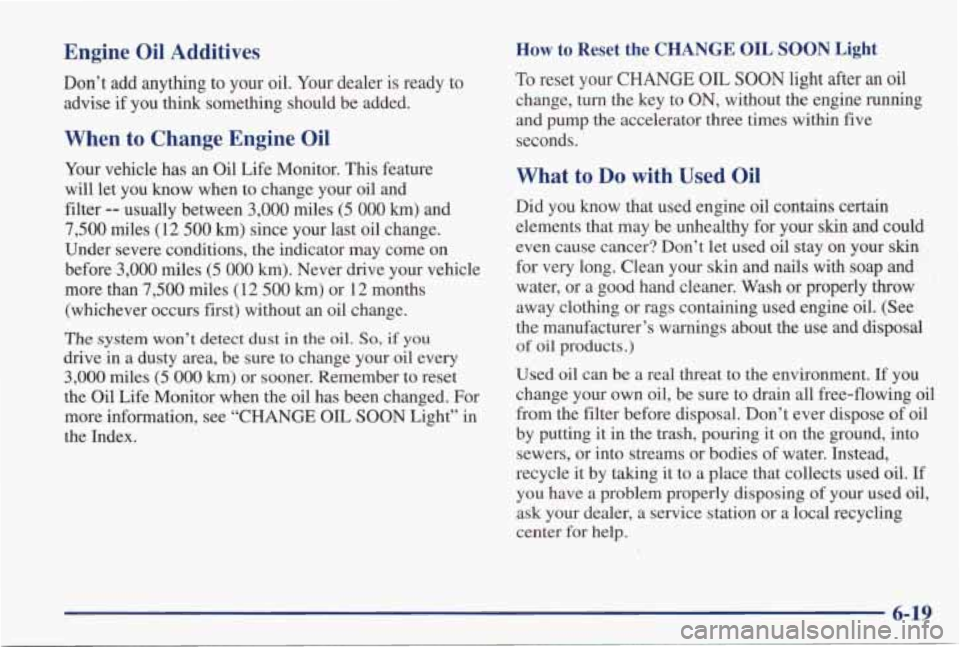
Engine Oil Additives
Don’t add anything to your oil. Your dealer is ready to advise
if you think something should be added.
How to Reset the CHANGE OIL SOON Light
When to Change Engine Oil
Your vehicle has an Oil Life Monitor. This feature
will let you know when to change your oil and
filter
-- usually between 3,000 miles (5 000 km) and
7,500 miles (12 500 km) since your last oil change.
Under severe conditions, the indicator may come
on
before 3,000 miles (5 000 km). Never drive your vehicle
more than
7,500 miles (12 500 km) or 12 months
(whichever occurs first) without an oil change.
The system won’t detect dust in the oil. So, if you
drive in a dusty area, be sure to change your oil every
3,000 miles (5 000 km) or sooner. Remember to reset
the Oil Life Monitor when the oil has been changed. For
more information, see “CHANGE
OIL SOON Light” in
the Index.
To reset your CHANGE OIL SOON light after an oil
change, turn
the key to ON, without the engine running
and pump the accelerator three times within five seconds.
What to Do with Used Oil
Did you know that used engine oil contains certain
elements that may be unhealthy for your skin and could
even cause cancer? Don’t let used oil stay on your skin
for very long. Clean your skin and nails with soap and
water, or a good hand cleaner. Wash or properly
throw
away clothing or rags containing used engine oil. (See
the manufacturer’s warnings about the use and
disposal
of oil products.)
Used oil can
be a real threat to the environment. If you
change your own oil, be sure to drain
all free-flowing oil
from the filter before disposal. Don’t ever dispose of oil
by putting it in the trash, pouring it on the ground, into
sewers, or into streams or bodies of water. Instead,
recycle it by taking it to a place that collects used oil.
If
you have a problem properly disposing of your used oil,
ask your dealer, a service station or a local recycling
center for help.
6-19
Page 310 of 402

NOTICE:
0
0
Using the wrong fluid can badly damage
brake system parts. For example, just a few
drops
of mineral-based oil, such as engine
oil, in your brake system can damage brake
system parts
so badly that they’ll have to be
replaced. Don’t let someone put in the
wrong kind
of fluid.
If you spill brake fluid on your vehicle’s
painted surfaces, the paint finish can be
damaged. Be careful not to spill brake fluid
on your vehicle.
If you do, wash it off
immediately. See “Appearance Care’’ in
the Index.
Brake Wear
Your vehicle has four-wheel disc brakes.
Disc brake pads have built-in wear indicators that
make
a high-pitched warning sound when the brake
pads are worn and new pads are needed. The
sound may
come and go or be heard all the time your vehicle is
moving (except when you are pushing on the brake
pedal firmly).
The brake wear warning sound means that soon
your brakes won’t work well. That could lead to
an accident. When you hear the brake wear
warning sound, have your vehicle serviced.
I NOTICE:
Continuing to drive with worn-out brake pads
could result in costly brake repair.
6-35
Page 350 of 402
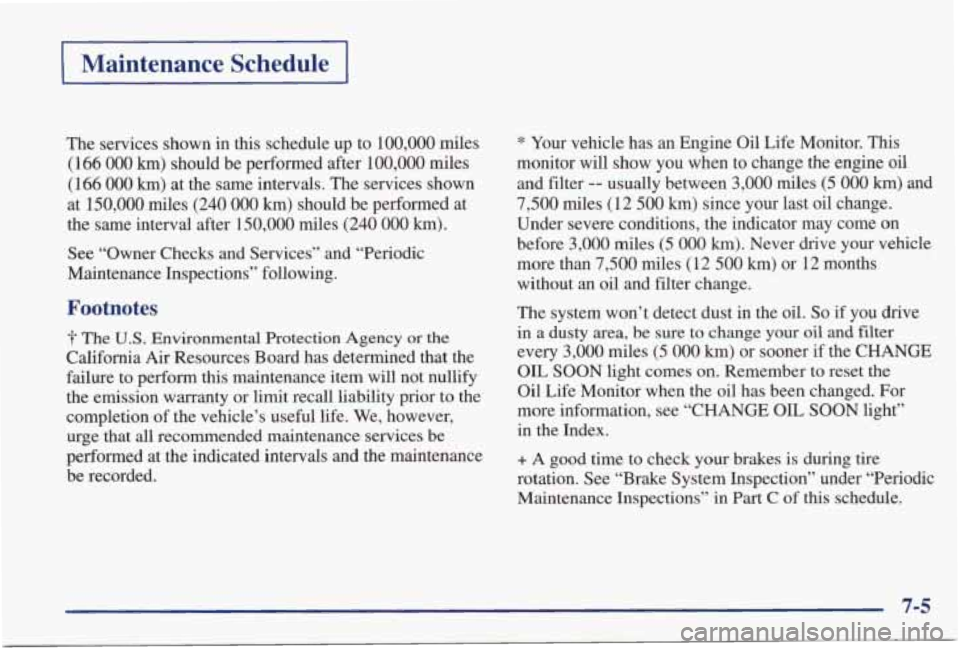
Maintenance Schedule
The services shown in this schedule up to 100,000 miles
(166
OOO km) should be performed after 100,000 miles
(166
000 km) at the same intervals. The services shown
at
150,000 miles (240 000 km) should be performed at
the same interval after 150,000 miles
(240 000 km).
See “Owner Checks and Services” and “Periodic
Maintenance Inspections” following.
Footnotes
? The US. Environmental Protection Agency or the
California Air Resources Board has determined that the
failure to perform
this maintenance item will not nullify
the emission warranty or limit recall liability prior
to the
completion
of the vehicle’s useful life. We, however,
urge that
all recommended maintenance services be
performed at the indicated intervals and the maintenance be recorded.
* Your vehicle has an Engine Oil Life Monitor. This
monitor will show you when to change the engine oil
and filter
-- usually between 3,000 miles (5 OOO km) and
7,500 miles (12 500 km) since your last oil change.
Under severe conditions, the indicator may come
on
before 3,000 miles (5 000 km). Never drive your vehicle
more than
7,500 miles (12 500 km) or 12 months
without
an oil and filter change.
The system won’t detect dust
in the oil. So if you drive
in
a dusty area, be sure to change your oil and filter
every 3,000 miles (5 000 km) or sooner if the CHANGE
OIL SOON light comes on. Remember to reset the
Oil Life Monitor when the oil has been changed. For
more information, see “CHANGE
OIL SOON light”
in the Index.
+ A good time to check your brakes is during tire
rotation. See “Brake System Inspection” under “Periodic
Maintenance Inspections”
in Part C of this schedule.
Page 388 of 402
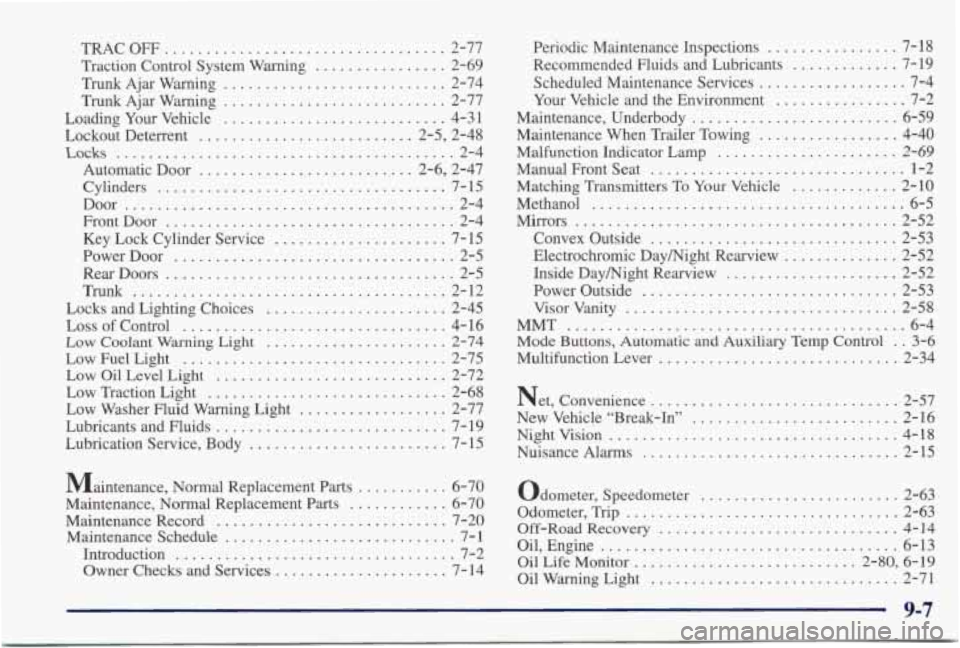
TRACO FF ................... ... 2-77
Trunk Ajar Warning
........................... 2-74
Trunk Ajar Warning
........................... 2-77
Loading Your Vehicle
........................... 4-3 1
Lockout Deterrent .......................... 2-5, 2-48
Automatic Door
.......................... 2-6, 2-47
Cylinders
................................... 7-15
Door
........................................ 2-4
FrontDoor
................................... 2-4
Key Lock Cylinder Service
..................... 7-15
PowerDoor
.................................. 2-5
RearDoors
................................... 2-5
Locks and Lighting Choices
...................... 2-45
Loss
of Control ................................ 4- 16
Low Coolant Warning Light ...................... 2-74
Low Fuel Light ................................ 2-75
Low Oil Level Light
............................ 2-72
Low Traction Light
............................. 2-68
Low Washer Fluid Warning Light
.................. 2-77
Lubricants and Fluids
............................ 7- 19
Lubrication Service, Body
........................ 7-15
Maintenance, Normal Replacement parts
........... 6-70
Maintenance, Normal Replacement
Parts ............ 6-70
Maintenance Record
............................ 7-20
Maintenance Schedule
............................ 7- 1
Introduction .................................. 7-2
Owner Checks and Services
..................... 7-14
Traction Control System Warning
.... ..... 2-69
Locks ......................................... 2-4
Trunk
...................................... 2-12 Periodic Maintenance Inspections
...... .... 7-18
Recommended Fluids and Lubricants ............. 7-19
Scheduled Maintenance Services
.................. 7-4
Your Vehicle and the Environment ................ 7-2
Maintenance. Underbody
......................... 6-59
Maintenance When Trailer Towing
................. 4-40
Malfunction Indicator Lamp
...................... 2-69
Manual Front Seat ............................... 1-2
Matching Transmitters
To Your Vehicle ............. 2-10
Methanol
...................................... 6-5
Mirrors
....................................... 2-52
Convex Outside
.............................. 2-53
Electrochromic Daymight Rearview
.............. 2-52
Inside Daymight Rearview
..................... 2-52
Power Outside
............................... 2-53
Visor Vanity
................................. 2-58
MMT
......................................... 6-4
Mode
Buttons. Automatic and Auxiliary Temp Control . . 3-6
Multifunction Lever
............................. 2-34
Net. Convenience
.............................. 2-57
New Vehicle “Break-In”
......................... 2-16
Nightvision
................................... 4-18
Nuisance Alarms
............................... 2-15
Odometer. Speedometer
...... ......... 2-63
Odometer. Trip
................................. 2-63
Off-Road Recovery
............................. 4-14
Oil, Engine .................................... 6-13
Oil Life Monitor
........................... 2-80. 6-19
Oil Warning Light .............................. 2-71
9-7